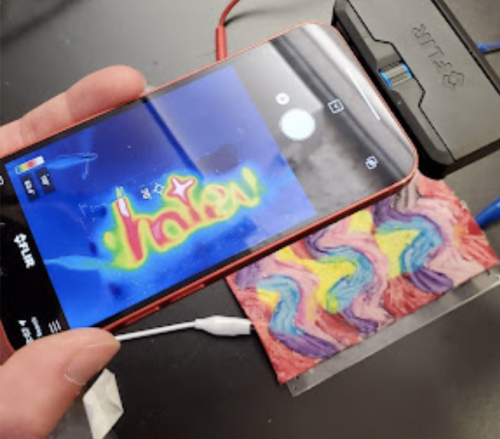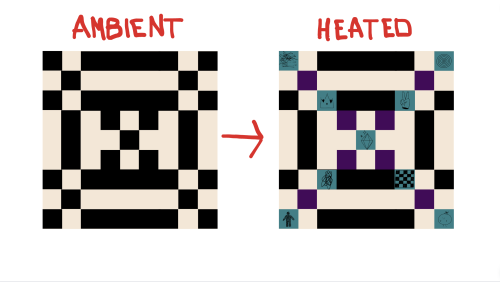Thermochromic Ink & Soft Interactivity
This is an artist page by Serena Zam. This project was part of the 2023 CATS+ Computer Club cohort.
What is thermochromic ink?
Thermochromic ink is a pigment that can change color or disappear due to a temperature change. Though this medium sounds fancy, you’ve likely encountered it in objects like mood rings, nail polish, or novelty cups. It is also surprisingly affordable, especially through the vendor, SolarColorDust.com. For this project, I used their Ultra Thermal Dusts, which transition from one color to another when exposed to heat that is 86 degrees or hotter. As the name suggests, this is produced as a fine powder. To use it as paint, I mixed the powder with an acrylic paint medium.
Exciting Applications
Many projects utilize thermochromic material and its color-changing properties. One of my favorites is designer Richard Vijgen’s tapestry woven with thermochromic yarn that changes color in response to Wi-Fi signals.
Background
I was first introduced to thermochromic ink through a workshop led by Taylor Tabb at ITP Camp in 2022. By the end of the workshop, I had a semi-successful notecard-sized proof-of-concept composed of a painted piece of canvas, a wire bent into the shape of the phrase “i hate u”, and an acrylic backing. When an electrical current is introduced to each end of the wire–producing heat–the paint changes colors and reveals the shape of the wire underneath. The result was fun, but not particularly legible without a heat-sensing camera. Since the entire canvas was covered in thermochromic ink, the heat “leaked” beyond the shape of the wire and made the result look like a messy blob rather than a phrase. I knew if I worked with this medium again, I would have to take a different approach, most notably applying the thermochromic pigment only to the areas I intended to change colors.

Thermochromic Quilt
Project Ideation
The final exhibit for the residency was devised from a series of conversations and themes returned to again and again by our cohort of artists. My resulting project stitches together a couple of these persisting topics: alternative or soft interfaces and tactile play. I was interested in disguising technology and providing an interactive, animated experience outside of what is experienced through screens. My goal for my art piece was to create a subtle, but instantaneous transition based on audience interaction.
Result
I made a textile art piece composed of 81 canvas squares sewn together. In its ambient state, it is black and white and reminiscent of a QR code. When heat is applied to the piece, some of the black squares change color and reveal painted images made by my fellow CATS+ residents. This heated design is inspired by quilting patterns. Though my education is in computer science, I often prefer to use traditional techniques–in this case, painting and sewing–over digital or software-based mediums. Instead, technology is most present in my work thematically as I use my practice to contemplate questions about the impact and ethics of the devices, algorithms, and machines that saturate modern life.

My original plan was to attach heating pads from Ada Fruit to the back of the piece and–using an Arduino–create a basic circuit controlled by a button. When someone presses the button, heat is applied to the piece, resulting in the desired transformation. However, the heating pads I used did not get hot enough to trigger the color change. I also tried using Peltier modules and conductive tape to disperse the heat. Though the modules got hot enough, I was not able to find an efficient way to disperse the heat to all the required areas with the conductive tape I had on hand. Because of time constraints, I was not able to find a good solution for heating the piece from behind. Therefore, the resulting display at the exhibit included a small hand-held heat gun mounted below the piece. Guests were encouraged to use the device to heat the textile and interact with it on their terms. Unexpectedly, this improvisation added to the experience as it encouraged a more tactile and intimate interaction experience than the original concept.

